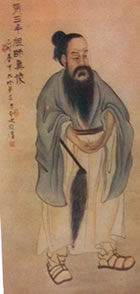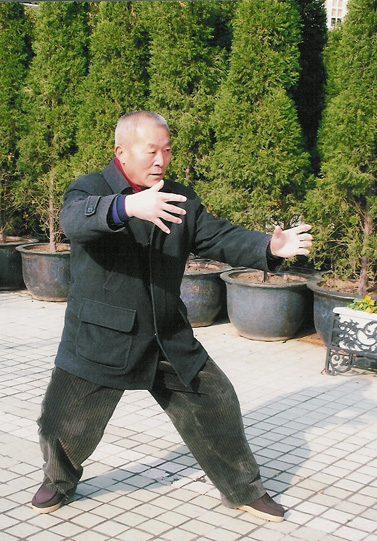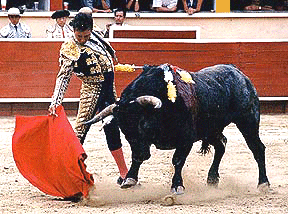
I was excited to see
Douglas Wile
, one of the heavies in terms of martial arts scholarship, writing an article in the
Journal of Asian Martial Arts.Fifteen years ago when this magazine first came out I was ecstatic. Imagine a martial arts magazine which insists on footnotes and bibliographies in every article! I thought it was a dream come true after years of wishing I was still 10 years old so I could appreciate martial arts writing.
The current addition has 13 contributors. There are two without degrees, two have M.A.'s, one has an M.S., one is an Acupuncturist (M.A.),
and eight have Ph.D.'s. Wow, and still most of the writing leaves me wishing for younger days. To be fair, most academic writing is genetically predestined to be boring. At least this stuff is mostly written by people involved in the arts, not by "objective outsiders."
I guess I am a child of the Internet, because I'm finding it harder and harder to read full length books and articles. I still love old media, but it takes so long to get to the point. I mean this stuff should have one of those
"Don't operate heavy machinery" warning labels. Again, to be fair, I'm addicted to pithy blog posts and I needed to catch up on some sleep.

Douglas Wile's article is called
"Taijiquan and Daoism; From Religion to Martial Art--and Martial Art to Religion." To really do it justice I would have to read the whole thing again. Honestly, I'm in one of those deep practice phases where a few hours of profound internal training makes me want to sleep-- y'all will have to settle for my vague dream like memories.
The gist of Wile's article is that facts about Taijiquan prior to 1900 are really hard to come by but that hasn't stopped lineage holders and historians from freely making sh-t up and pretending it's factual.
One can easily understand why a lineage holder would want to make stuff up. It makes them seem like they have the only key to the chest of treasures while at the same time allowing them the (false) modesty of claiming that their teacher's teacher's teacher was like, dude, really, really good.
It's harder to understand why historians would make stuff up. In America if we catch a historian making stuff up, we use their books for compost. But then again, the various "wings" of the Communists and the Nationalists, were in a propaganda war to prove that only their (death cult) ideologies and allegiances would make Chinese people better and stronger.
Even though Wile spends a lot of time explaining what all these 20th Century scholars thought, I have the feeling he would agree with me when I say,
taijiquan has picked up so much baggage we ought to throw out all the books and start over.Wile dances around the question: Why in light of so little direct evidence for Taijiquan's Daoist roots, are there so many people trying to prove a connection? He writes about Taijiquan's "inventor," the magical dreamer
Daoist immortal Zhang Sanfeng:
For sheer contentiousness, the Zhang Sanfeng case can only be compared to issues of racism, sexism, abortion and homosexuality in American culture. At the dawn of the 21st century, the pendulum has once again swung towards the myth-makers. Western practitioners of taijiquan, with their monotheistic, atheistic, or "only begotten son" backgrounds are apt to view Zhang Sanfeng as simply an historical figure with some innocent Daoist embellishments. They are not likely to understand China's culture wars, polytheism, or embodied immortality..."
In summary, his point is that Taijiquan never really had much to do with Daoism, until 20th century people started mixing in a lot of Neidan (inner alchemy), TCM jargon, some quotes from the Daodejing and the Zhuangzi, and claims about health. Oh yeah, and some stories. And then a bunch of fake modern scholars said none of that is true-- but what
they said wasn't true either (so there!). Now that running a business isn't banned in China, there is this new feel good, feel strong, feel Chinese, feel Taijiquan-is-part-of-Daoism, marketing ethos. No real content.
And
Wile gets kind of mad about it,
"Daoist Chauvinism should never be underestimated, and we need only remind ourselves that some Daoist apologists have claimed that Buddhism sprang from seeds planted by Laozi when he rode westwards on his ox."
 Them's figtin' words.
Them's figtin' words. Bumper stickers have all but disappeared from San Francisco (which I attribute to uniformity of thought); however, I spotted one today. It read,
"Lighten Up!"For the record, those Daoist "apologists," were not writing history, they were writing secret scripture. The name
Laozi means "old seed," but if we are talking about the
Santianneijing
(3rd Century), then it was
Laojun (the
inspiration behind the
Daodejing
) which actually incarnated as the Buddha so that the western barbarians would have their own version of "The Way," and would thus have their own home grown basis for mutual cooperation and understanding.
Never mind, that's an argument for another day.
I respect Wile's contribution to understanding the history of Taijiquan,
I thank him for letting us know it's all a bunch of lies!My argument with him is this: Orthodox Daoism never claimed Taijiquan as a Daoist art and I doubt it ever will. Monastic Daoism has of late decided that Taijiquan is part of its shtick. Since the 1980's is has also decided that gongfu movies are part of its shtick, big whoop. Monastic Daoism never really had a central authority, from the sidelines it kinda seems like Buddhism with a little inner alchemy for the "we must appear to be loyal Chinese" set. All this means very little.
If you want to know what the origins of Taijiquan are, you are going to have to soften your definitions, and blur your categories.
Taijiquan only came into being because it was able to obscure it's origins in religion, popular culture, and secret societies. By the start of the 20th century participation in trance cults or exorcistic and processional dance, was considered politically dangerious and ideologically backwards. That's why they invented and then tried to tack on the suspicious label, "purely philosophical" Daoism.
Likewise, some combination of fear, modernity, and ideology led people to strip down their communal ritual performance traditions into pure "Martial Arts."People over here were arguing about why they took the Fajing (power issuing?) out of Yang and Wu styles of Taijiquan. I'll tell you why. Fajing is a way to strike terror into your audience,
a way to let people know the god has taken possession of the dancer.Now, if you'll excuse me,
I'm going to go put the Fajing back in my form! Last month I was at a family gathering and there was a five month old girl who was crying. Her aunt, who has several wild children of her own, tried rocking her and then bouncing her, but the baby was still crying. Then with a big grin she announced, "We are going to have to try Monkey Swings." I can now verify from my observations that monkey swings are an effective crying control mechanism.
Last month I was at a family gathering and there was a five month old girl who was crying. Her aunt, who has several wild children of her own, tried rocking her and then bouncing her, but the baby was still crying. Then with a big grin she announced, "We are going to have to try Monkey Swings." I can now verify from my observations that monkey swings are an effective crying control mechanism.
 As you are imaging this, you might think that the baby's head would flop backwards like that of the child on the swing above. But it didn't. The baby's head stayed right in line with its torso. This was a five month old I was watching, a younger baby probably would have had a floppy head. An older child would certainly be able to do this, but in most cases it would be obvious that they were using voluntary neck muscles.
As you are imaging this, you might think that the baby's head would flop backwards like that of the child on the swing above. But it didn't. The baby's head stayed right in line with its torso. This was a five month old I was watching, a younger baby probably would have had a floppy head. An older child would certainly be able to do this, but in most cases it would be obvious that they were using voluntary neck muscles.

 Even if you are practicing with a superior opponent who wants to beat you, still the appropriate response when you get in a losing situation is to slow down and give all your attention to understanding/feeling what your opponent is doing.
Even if you are practicing with a superior opponent who wants to beat you, still the appropriate response when you get in a losing situation is to slow down and give all your attention to understanding/feeling what your opponent is doing. Southern Shaolin, like Choy Li Fut, seems like it was formed by people familiar with fighting in confined spaced, narrow corridors, and tight corners.
Southern Shaolin, like Choy Li Fut, seems like it was formed by people familiar with fighting in confined spaced, narrow corridors, and tight corners. Years ago I had the opportunity to meet
Years ago I had the opportunity to meet 


 I heard a story about a guy who wanted to study martial arts from a Master who lived up in the Mountains in Taiwan.
I heard a story about a guy who wanted to study martial arts from a Master who lived up in the Mountains in Taiwan. I was excited to see
I was excited to see  Douglas Wile's article is called
Douglas Wile's article is called  Them's figtin' words. Bumper stickers have all but disappeared from San Francisco (which I attribute to uniformity of thought); however, I spotted one today. It read, "Lighten Up!"
Them's figtin' words. Bumper stickers have all but disappeared from San Francisco (which I attribute to uniformity of thought); however, I spotted one today. It read, "Lighten Up!" Well after making it through that very twisty tail of the pig, I'm already enjoying the soft sensitive pillow nose of the rat! (Because I live in a Chinese city, I only had one class this morning and I spent the rest of the day in bed.)
Well after making it through that very twisty tail of the pig, I'm already enjoying the soft sensitive pillow nose of the rat! (Because I live in a Chinese city, I only had one class this morning and I spent the rest of the day in bed.)
 I'm old enough, and was born in the right place, to remember the real New Age. The basis of the New Age movement was the hippy idea that we could change the metaphors we live by. If we changed the games children played from competitive ones to cooperative ones, and we change the stories--the mythologies-- our society perpetuates, we could bring about a new way of being, a New Age. Frankly, it was a fun time to be a kid, even if putting my Cheerios underneath a pyramid didn't really change the taste and even the most cooperative game can be made competitive if there are enough eight-year-old-boy hormones to go around.
I'm old enough, and was born in the right place, to remember the real New Age. The basis of the New Age movement was the hippy idea that we could change the metaphors we live by. If we changed the games children played from competitive ones to cooperative ones, and we change the stories--the mythologies-- our society perpetuates, we could bring about a new way of being, a New Age. Frankly, it was a fun time to be a kid, even if putting my Cheerios underneath a pyramid didn't really change the taste and even the most cooperative game can be made competitive if there are enough eight-year-old-boy hormones to go around. That experience was still not enough to stop me from cringing at the New Age bravado apparent in these
That experience was still not enough to stop me from cringing at the New Age bravado apparent in these  hours start to fall. It was a really finicky process. If he didn't add enough gas, the temperature would keep climbing, and if he added too much if would fall too fast. Both scenarios would ruin the glaze. To make it work he had to watch and continually adjust the process for many hours. And it's not like he could just look at a thermostat, the critical issue was how hot the clay was. When the temperature was rising he could look at clay cones which are pre-formulated to melt at specific temperatures, but that didn't work when the temperature was falling or stalling.
hours start to fall. It was a really finicky process. If he didn't add enough gas, the temperature would keep climbing, and if he added too much if would fall too fast. Both scenarios would ruin the glaze. To make it work he had to watch and continually adjust the process for many hours. And it's not like he could just look at a thermostat, the critical issue was how hot the clay was. When the temperature was rising he could look at clay cones which are pre-formulated to melt at specific temperatures, but that didn't work when the temperature was falling or stalling.